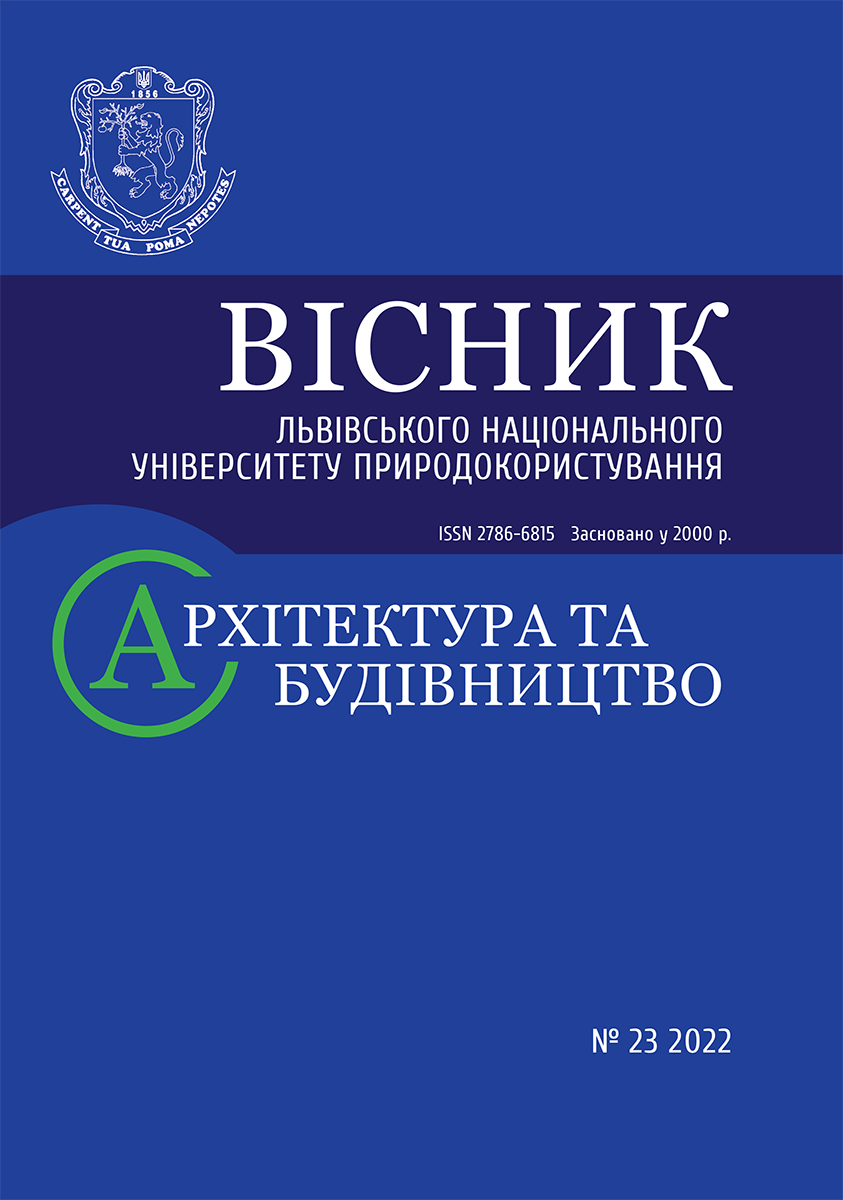BASIC CONCEPTS OF DETERMINING THE CRACK RESISTANCE OF REINFORCED CONCRETE STRUCTURES BY THE PRINCIPLE OF FRACTURE MECHANICS
Keywords:
reinforced concrete, crack, criteria, models, destruction, crack resistance, reinforcement corrosion, concrete carbonization, durabilityAbstract
This paper presents the generalized results of the analysis and synthesis of scientific and technical sources on studying heavy concrete and reinforced concrete structures and buildings based on the fracture mechanics principles. The research results on the crack resistance of concrete and reinforced concrete structures over the last 25–30 years are presented. The occurrence and normal cracks development conditions and the various influence factors that testify to the benefit of fracture mechanics methods are set up. In particular, a method of calculating the stress intensity factor for beam structures with bending cracks is developed. In addition, the moments of crack formation and cracks opening in steel-reinforced concrete slabs are determined. A method of crack resistance during long-term bending, taking into account the creep and shrinkage of concrete, is developed. Calculation results are compared with experimental data. Calculation models and solved problems on the formation and subcritical growth of cracks in a non-stationary setting are formulated. A method of calculating the forces in the rod reinforcement around the crack is developed. The moment of crack formation and calculation of crack opening using the methods of the mathematical theory of cracks and other aspects of calculating such structures is determined. The results of theoretical and experimental studies of the long-term reinforced concrete structures on reliability and durability and assessing a residual resource are summarized too. On the basis of the generalized data given in the publications, the methods of technical diagnostics and repair and restoration work with strengthening are worked out. It enables increasing the resource and reliability of the reinforced concrete buildings and structures.
References
Andreikiv O. E., Luchko Y. Y., Kovchyk S. E. Methodology for determining the crack resistance of reinforced concrete structures. Diagnostics, durability and regeneration of bridges of building structures with the use of modern technologies and materials. Lviv: Kamenyar, 1999. № 1. P. 6–17.
Andreikiv O. E., Luchko Yо. Yо., Hembara T. V. Calculation of reinforced concrete beam elements by methods of fracture mechanics: preprint / Physic-Mechanical Institute of the NAS of Ukraine. Lviv, 1993. № 183. 55 p.
Doroveiev V. S., Karpiuk V. M., Kraptovska O. M. Calculation of the strength of continuous reinforced concrete beams using a deformation model. Mechanics and physics of destruction of building materials and structures / According to the general ed. Y. Y. Luchko. Lviv: Kamenyar, 2007. Vol. 7. P. 223–237.
Luchko Y. Y. A method for assessing the reinforced concrete structures life, based on fracture mechanics. Physic-chemical mechanics of materials. Lviv, 2001. No 6. P. 75–84.
Luchko Y. Y. Basic concepts of the mechanics of the destruction of reinforced concrete. Physic-chemical mechanics of materials. Lviv, 1995. No 4. P. 42–48.
Luchko Y. Y. Determination of the stress state of reinforced concrete structures at the stage of operation by methods of fracture mechanics. Diagnostics, durability and reconstruction of bridges and building structures. Lviv: Kameniar, 2000. Vol. 2. P. 83–90.
Luchko Y. Y. Fracture mechanics approach to evaluation of residual life of ferroconcrete beam elements. Physico-chemical mechanics of materials. Lviv, 1999. No 5. P. 83–90.
Luchko Y. Y. The main environmental factors affecting the degradation of transport structures made of reinforced concrete and metal corrugated structures. Theory and practice of the development of the agro-industrial complex and rural areas: materials of the XXII International Scientific and Practical Forum, October 5–7, 2021. Lviv, 2021. Vol. 2. P. 203–206.
Luchko J., Nazarevich B., Kovalchuk V. Degradating concrete and reinforced building structures and long-term structures. Bulletin of Odessa State Academy of Civil Engineering and Architecture. Odessa: OSACEA, 2022. № 86. P. 35–46.
Luchko Y. Y., Chubrikov V. M., Lazar V. F. Strength, crack resistance and durability of concrete and reinforced concrete structures based on the principles of fracture mechanics / NAS of Ukraine, Karpenko Physico-mechanical institute. Lviv: Kamenyar, 1999. 348 p.
Luchko Y. Y., Hembara T. V. Methodical recommendations for calculating the crack resistance of reinforced concrete beam elements of structures / Physic-Mechanical Institute of the NAS of Ukraine. Lviv, 1995. 49 p.
Luchko Y. Y., Lazar V. F. Determination of the length of the pre-destruction zone in concrete and reinforced concrete beam elements of structures. Mechanics and physics of destruction of building materials and constructions. Lviv: Kameniar, 1998. Is. 3. P. 132–138.
Luchko Y. Y., Lazar V. F. Determination of stress and assessment of strength and crack resistance of reinforced concrete beam elements based on the principles of fracture mechanics. Bulletin of Lviv Polytechnic University. Theory and practice of construction. Lviv, 2002. No 441. P. 117–131.
Luchko Y. Y., Lazar V. F. Stress calculations and estimation of strength and crack growth resistance of reinforced concrete beam elements. Physic-chemical mechanics of materials. Lviv, 2002. Vol. 1. P. 107–116.
Luchko Y. Y. Lazar V. F., Chubrikov V. M. Strength of ferro-concrete element with a crack from a viewpoint of fracture mechanics. Physic-chemical mechanics of materials. Lviv, 2001. No 1. Р. 27–36.
Luchko Y. Y., Stashchuk A. M., Kovalenko P. B. Stress intensity coefficients and tangential stresses during peeling. Diagnostics of durability and reconstruction of bridges and building structures. Lviv: Kamenyar, 2004. Vol. 6. P. 87–92.
Makhutov M. A., Matvienko Yu. G. Fracture mechanics approaches in the concept of engineering safety. Physico-chemical mechanics of materials. Lviv, 1996. No 2. P. 35–42.
Nemirovskiy Ya. M. Investigation of the stress-strain state of reinforced concrete elements, taking into account the work of tensile concrete over a crack, and revision on this basis of the theory of calculating deformation and opening of cracks. Strength and rigidity of reinforced concrete structures. Moscow: Stroyizdat, 1968. 210 p.
Peresypkin E. N. Calculation of rod reinforced concrete elements. Moscow: Stroyizdat, 1988. 168 p.
Rudakov V. N. Some physical aspects of fracture mechanics of compressed beams and steel-concrete structures. Bulletin of Odessa State Academy of Civil Engineering and Architecture. 2006. No 23. P. 273–285.
Rudakov V. N., Dorofeiev V. S., Molodchenko H. O. Experimental and theoretical study of an eccentrically compressed steel-reinforced concrete element. Mechanics and physics of destruction of building materials and structures / According to the general ed. Y.Y. Luchko. Lviv: Kamenyar, 2007. Vol. 7. P. 320–333.
Rudakov V. N., Rakhim Saran, Starozhenko I. A. On the application of the Rice-Cherepanov energy criterion for assessing the strength of steel concrete structures. Mechanics and physics of the ruining of future materials and structures / ed. Y. Y. Luchko. Lviv: Kamenyar, 2005. No 6. P. 120–126.
Rusinko K. N., Artykova S. I. On the destruction of a solid body under an inhomogeneous stress state. Strength of Materials. 1973. No 2. Р. 43–47.


